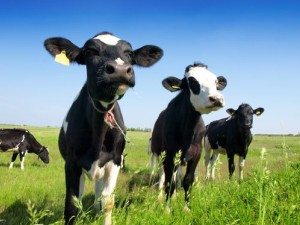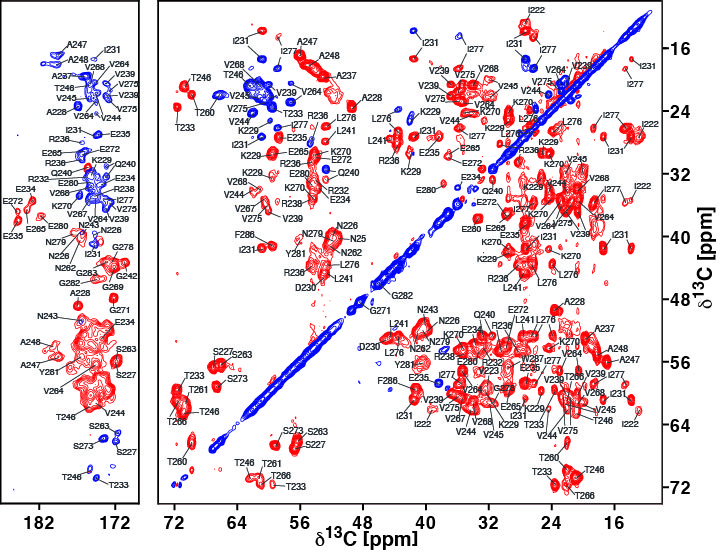 You will all be familiar with Mad Cow Disease (MCD), the devastating disease that led to the slaughter of many cattle in the 1990s (at its peak over 30 000 cows died from MCD per year). It has been estimated that in total, over a million cows met their untimely deaths, whilst at the same time, there are estimated to have been around 200 human deaths from the human variant of the disease (Creuzfeldt-Jakob disease). Our protein this month lies at the heart (or I should say the nerve centre) of this disease and first let's look at the strange story of the mysterious infectious agent behind another livestock disease scrapie.
You will all be familiar with Mad Cow Disease (MCD), the devastating disease that led to the slaughter of many cattle in the 1990s (at its peak over 30 000 cows died from MCD per year). It has been estimated that in total, over a million cows met their untimely deaths, whilst at the same time, there are estimated to have been around 200 human deaths from the human variant of the disease (Creuzfeldt-Jakob disease). Our protein this month lies at the heart (or I should say the nerve centre) of this disease and first let's look at the strange story of the mysterious infectious agent behind another livestock disease scrapie.
Scrapie is a fatal, neurodegenerative disease amongst sheep and goats. The disease is one of a group of diseases given the medical terms: Transmissable, spongiform encephalopathy. What baffled scientists for some time was that the infectious agent appeared to be a protein. (Recall from my Y12 lab lecture the central dogma from Francis Crick (RNA makes) DNA makes RNA makes protein) In scrapie, there are no nucleic acids in sight! In 1982, Stanley Prusiner purified the infectious agent and named it a prion, from the combination of protein and infection. 30 years on, there are still many unanswered questions underlying the molecular mechanism of prion disease, but the main concept has held fast. The prion proteins can exist in two distinct 3-dimensional structures or shapes (see top right). This statement in itself provokes uncomfortable reactions amongst structural biologists, biophysicists and biochemists ever since Christian B Anfinsen received the Nobel Prize for his fundamental work on the relationship between the amino acid sequence of a protein and its "unique" 3 D structure. Prusiner's prion seemed to be defying Anfinsen's elegant and seemingly unassailable law. So the prion protein can either be Dr. Jekyll, the kind and helpful person; or Mr. Hyde, the sinister uncontrollable force for evil. (You can read about Ebola virus proteins and Anfinsen's rule in an earlier Blog).
 Back to Jekyll and Hyde! The prion molecule is a relatively small protein, it is present in normal tissues where its function has largely been defined in spongiform diseases. Brain tissue of patients with CJD appears to be full of microscopic holes. Mutations in the normal prion gene as well as "infection" by prions induce the disease. The result is severe deterioration of brain function and ultimately death. I want to draw your attention however to the emerging awareness of the possibility of protein sequences defying Anfinsen's rule. If, as seems likely, a protein's amino acid sequence does not give rise to a single, thermodynamically stable structure, then the challenges of drug discovery and vaccination become even more daunting. You will recall that proteins have preferred secondary structures that include alpha helices and beta sheets. In prion disease, the diseased protein induces a change in the organisation of the intramolecular interactions including H bonds and other non-covalent interactions, to produce the infectious form. The remarkable feature of prion infections is that the "Hyde" conformation dominates Dr. Jekyll. That is, in the presence of the a small amount of diseased prion, all molecules in the normal conformation switch shape and take on that of the disease causing molecule.
Back to Jekyll and Hyde! The prion molecule is a relatively small protein, it is present in normal tissues where its function has largely been defined in spongiform diseases. Brain tissue of patients with CJD appears to be full of microscopic holes. Mutations in the normal prion gene as well as "infection" by prions induce the disease. The result is severe deterioration of brain function and ultimately death. I want to draw your attention however to the emerging awareness of the possibility of protein sequences defying Anfinsen's rule. If, as seems likely, a protein's amino acid sequence does not give rise to a single, thermodynamically stable structure, then the challenges of drug discovery and vaccination become even more daunting. You will recall that proteins have preferred secondary structures that include alpha helices and beta sheets. In prion disease, the diseased protein induces a change in the organisation of the intramolecular interactions including H bonds and other non-covalent interactions, to produce the infectious form. The remarkable feature of prion infections is that the "Hyde" conformation dominates Dr. Jekyll. That is, in the presence of the a small amount of diseased prion, all molecules in the normal conformation switch shape and take on that of the disease causing molecule. The physical basis of this phenomenon isn't entirely resolved, but early work on haemoglobin by Hill and Adair, followed by the work on regulatory enzymes by Koshland and Monod, Wyman and Changeux) and its oxygen binding properties provide insight into the molecular events in protein shape-shifting (and, by the way, I can strongly recommend Robert Plant's recent collaboration with the Space-Shifters). Getting back to Science, it is now widely accepted that proteins adopt a preferred shape (or conformation, often referred to as open and closed, see RHS), but in the presence of regulatory molecules (metabolites or proteins, often called ligands), an alternative shape can be induced. This represents a mechanism for switching protein function in a simple and rapid manner. It would seem that prions adopt not only subtly different shapes, but almost completely reconfigure their 3D structure, and more importantly, this gives them their Jekyll and Hyde, split personality. The question remains as to whether other factors are involved in promoting this transition, but nevertheless, the study of prions will ensure that our understanding of the relationship between protein primary structure (amino acid sequence) and tertiary structure, and hence function, is properly understood!
The physical basis of this phenomenon isn't entirely resolved, but early work on haemoglobin by Hill and Adair, followed by the work on regulatory enzymes by Koshland and Monod, Wyman and Changeux) and its oxygen binding properties provide insight into the molecular events in protein shape-shifting (and, by the way, I can strongly recommend Robert Plant's recent collaboration with the Space-Shifters). Getting back to Science, it is now widely accepted that proteins adopt a preferred shape (or conformation, often referred to as open and closed, see RHS), but in the presence of regulatory molecules (metabolites or proteins, often called ligands), an alternative shape can be induced. This represents a mechanism for switching protein function in a simple and rapid manner. It would seem that prions adopt not only subtly different shapes, but almost completely reconfigure their 3D structure, and more importantly, this gives them their Jekyll and Hyde, split personality. The question remains as to whether other factors are involved in promoting this transition, but nevertheless, the study of prions will ensure that our understanding of the relationship between protein primary structure (amino acid sequence) and tertiary structure, and hence function, is properly understood! Just as a small footnote, I thought I would mention that visualising protein conformational changes is extremely difficult. We often have to extrapolate from crystal structures at either side of the equilibrium. Sometimes NMR spectroscopy (LHS), at high magnetic field strengths, can give us structural and dynamic information, but we mostly rely on techniques such as fluorescent spectroscopy to tell us indirectly about these shape changes. This field is in urgent need of a breakthrough in physics that would allow us to capture proteins in action in real time.
Just as a small footnote, I thought I would mention that visualising protein conformational changes is extremely difficult. We often have to extrapolate from crystal structures at either side of the equilibrium. Sometimes NMR spectroscopy (LHS), at high magnetic field strengths, can give us structural and dynamic information, but we mostly rely on techniques such as fluorescent spectroscopy to tell us indirectly about these shape changes. This field is in urgent need of a breakthrough in physics that would allow us to capture proteins in action in real time.
No comments:
Post a Comment